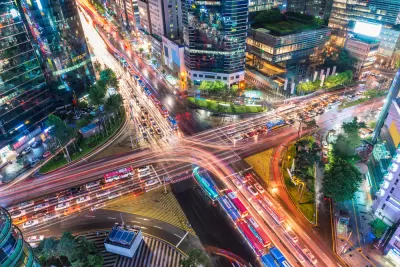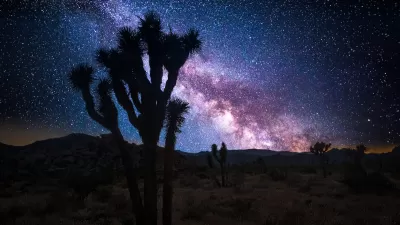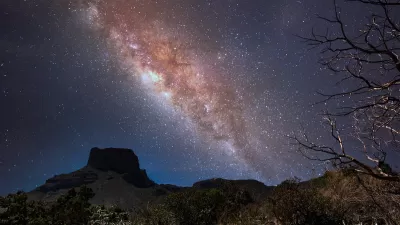Of all the inventions of the modern world, few have been so embraced as artificial light. But constant light, like that which floods city streets and illuminates buildings, is not necessarily healthy or safe. Some cities are trying to go dark.

Electric light has made cities eminently more functional, and visually riotous, than they otherwise would have been. It's the externality that no one seems to mind. Satellite photos of nighttime in the United States, revealing vast lightening-colored blobs and streaks, testify to the ways that we have altered the visual landscape. What is good for functionality may not, however, be good for human health, the environment, our sense of wonder, and even our safety.
Emerging research suggests that our constant flood of light is, via hormonal disruption and sleep disorders, doing awful things to our metabolism and overall health. It confuses animals and creates a "monochrome canopy of muted light grey to almost-but-not-quite-black, dotted, depending on the size of your city, with a dim handful of stars." Surprisingly, excessive light may not make cities more safe or easier to navigate. It turns out that the human eye responds more to contrasts -- whatever the background level of light may be -- than to brightness as such.
A new generation of architects, planners, and lighting designers are figuring out ways to light cities and buildings more smartly, efficiently, and attractively, without incurring the glare and leakage that characterizes the majority of outdoor lighting. "The trick is to illuminate change—steps, doors, paths—rather than entire landscapes."
“There is no universally applicable conclusion that comes out of criminology research that shows that more light means less crime.” Overlighting, in fact, can be worse than dimly lit spaces for several reasons, beginning with the risk of glare. As USC Professor Travis Longcore put it, “If you have bright lights, the shadows become much darker.”
FULL STORY: Darker, Safer

Planetizen Federal Action Tracker
A weekly monitor of how Trump’s orders and actions are impacting planners and planning in America.

Restaurant Patios Were a Pandemic Win — Why Were They so Hard to Keep?
Social distancing requirements and changes in travel patterns prompted cities to pilot new uses for street and sidewalk space. Then it got complicated.

Map: Where Senate Republicans Want to Sell Your Public Lands
For public land advocates, the Senate Republicans’ proposal to sell millions of acres of public land in the West is “the biggest fight of their careers.”

Maui's Vacation Rental Debate Turns Ugly
Verbal attacks, misinformation campaigns and fistfights plague a high-stakes debate to convert thousands of vacation rentals into long-term housing.

San Francisco Suspends Traffic Calming Amidst Record Deaths
Citing “a challenging fiscal landscape,” the city will cease the program on the heels of 42 traffic deaths, including 24 pedestrians.

California Homeless Arrests, Citations Spike After Ruling
An investigation reveals that anti-homeless actions increased up to 500% after Grants Pass v. Johnson — even in cities claiming no policy change.
Urban Design for Planners 1: Software Tools
This six-course series explores essential urban design concepts using open source software and equips planners with the tools they need to participate fully in the urban design process.
Planning for Universal Design
Learn the tools for implementing Universal Design in planning regulations.
Heyer Gruel & Associates PA
JM Goldson LLC
Custer County Colorado
City of Camden Redevelopment Agency
City of Astoria
Transportation Research & Education Center (TREC) at Portland State University
Camden Redevelopment Agency
City of Claremont
Municipality of Princeton (NJ)





























